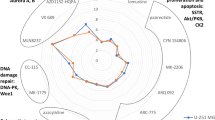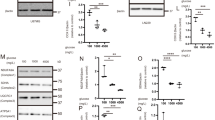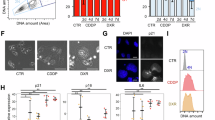Abstract
Checkpoint mechanism plays a crucial role in ensuring genomic integrity during cell cycle. Loss of checkpoint function is known to induce genomic instability and to alter ploidy of dividing cells. In this study, we examined mechanisms of hyperploid formation in glioma cells by treatment with nocodazole, which activates spindle assembly checkpoint by inhibiting microtubule polymerization. By prolonged nocodazole treatment, U251MG human glioma cell, which has a p53 mutation, underwent transient arrest at mitosis, and subsequently exited from mitotic arrest (termed ‘mitotic slippage’) followed by DNA replication without cytokinesis, resulting in hyperploid formation. Additionally, the heterogeneity in the number of centrosomes per cell increased during the hyperploid formation, suggesting that these hyperploid cells have genomic instability. By employing LN382 glioma cell that has a temperature-sensitive p53 mutation, we found that the activation of p53 prevents hyperploid formation after the prolonged nocodazole treatment. Furthermore, staurosporine, an inhibitor for a broad range of serine/threonine kinases including cdc2, was found to enhance hyperploid formation in U251MG cells by accelerating the induction of mitotic slippage. Interestingly, inhibitors specific for cdc2 kinase prevented the G2 to M transition but did not accelerate mitotic slippage, suggesting that staurosporine-sensitive kinases other than cdc2 are required for maintenance of spindle assembly checkpoint. Moreover, the enhancement of hyperploid formation by staurosporine was also blocked by p53-dependent G1 checkpoint. These results suggest that abrogation of G1 checkpoint is a critical factor for formation of hyperploid cells after the mitotic slippage.
This is a preview of subscription content, access via your institution
Access options
Subscribe to this journal
Receive 50 print issues and online access
$259.00 per year
only $5.18 per issue
Buy this article
- Purchase on SpringerLink
- Instant access to full article PDF
Prices may be subject to local taxes which are calculated during checkout












Similar content being viewed by others
References
Abe K, Yoshida M, Usui T, Horinouchi S and Beppu T. . 1991 Exp. Cell Res. 192: 122–127.
Andreassen PR and Margolis RL. . 1994 J. Cell. Biol. 127: 789–802.
Bruno S, Ardelt B, Skierski JS, Traganos F and Darzynkiewicz Z. . 1992 Cancer Res. 52: 470–473.
Chau AS and Shibuya EK. . 1999 J. Biol. Chem. 274: 32085–32090.
Crissman HA, Gadbois DM, Tobey RA and Bradbury EM. . 1991 Proc. Natl. Acad. Sci. USA 88: 7580–7584.
Cross SM, Sanchez CA, Morgan CA, Schimke MK, Ramel S, Idzerda RL, Raskind WH and Reid BJ. . 1995 Science 267: 1353–1356.
Davis PD, Hill CH, Keech E, Lawton G, Nixon JS, Sedgwick AD, Wadsworth J, Westmacott D and Wilkinson SE. . 1989 FEBS Lett. 259: 61–63.
Di Leonardo A, Khan SH, Linke SP, Greco V, Seidita G and Wahl GM. . 1997 Cancer Res. 57: 1013–1019.
Fukasawa K, Choi T, Kuriyama R, Rulong S and Vande Woude GF. . 1996 Science 271: 1744–1747.
Gautier J, Norbury C, Lohka M, Nurse P and Maller J. . 1988 Cell 54: 433–439.
Goto H, Tomono Y, Ajiro K, Kosako H, Fujita M, Sakurai M, Okawa K, Iwamatsu A, Okigaki T, Takahashi T and Inagaki M. . 1999 J. Biol. Chem. 274: 25543–25549.
Hall LL Th'ng JP, Guo XW, Teplitz RL and Bradbury EM. . 1996 Cancer Res. 56: 3551–3559.
Hartwell LH and Kastan MB. . 1994 Science 266: 1821–1828.
Herbert JM, Seban E and Maffrand JP. . 1990 Biochem. Biophys. Res. Commun. 171: 189–195.
Hirota T, Morisaki T, Nishiyama Y, Marumoto K, Tada K, Hara N, Masuko N, Inagaki M, Hatakeyama K and Saya H. . 2000 J. Cell. Biol. 149: 1073–1086.
Khan SH and Wahl GM. . 1998 Cancer Res. 58: 396–401.
Kung AL, Sherwood SW and Schimke RT. . 1990 Proc. Natl. Acad. Sci. USA 87: 9553–9557.
Lanni JS and Jacks T. . 1998 Mol. Cell. Biol. 18: 1055–1064.
Li CJ, Li YZ, Pinto AV and Pardee AB. . 1999 Proc. Natl. Acad. Sci. USA 96: 13369–13374.
Lingle WL, Lutz WH, Ingle JN, Maihle NJ and Salisbury JL. . 1998 Proc. Natl. Acad. Sci. USA 95: 2950–2955.
Minn AJ, Boise LH and Thompson CB. . 1996 Genes Dev. 10: 2621–2631.
Paulovich AG, Toczyski DP and Hartwell LH. . 1997 Cell 88: 315–321.
Pu RT and Osmani SA. . 1995 EMBO J. 14: 995–1003.
Rieder CL and Palazzo RE. . 1992 J. Cell. Sci. 102: 387–392.
Sablina AA, Agapova LS, Chumakov PM and Kopnin BP. . 1999 Cell. Biol. Int. 23: 323–334.
Stewart ZA, Leach SD and Pietenpol JA. . 1999 Mol. Cell. Biol. 19: 205–215.
Takenaka K, Moriguchi T and Nishida E. . 1998 Science 280: 599–602.
Tsuiki H, Nitta M, Furuya A, Hanai N, Fujiwara T, Inagaki M, Kochi M, Ushio Y, Saya H and Nakamura H. . 1999 J. Cell. Biochem. 76: 254–269.
Usui T, Yoshida M, Abe K, Osada H, Isono K and Beppu T. . 1991 J. Cell. Biol. 115: 1275–1282.
Verdoodt B, Decordier I, Geleyns K, Cunha M, Cundari E and Kirsch-Volders M. . 1999 Mutagenesis 14: 513–520.
Zachariae W. . 1999 Curr. Opin. Cell. Biol. 11: 708–716.
Acknowledgements
We thank Dr J Moon for editing the manuscript and T Arino for secretarial assistance. This work was supported by a grant for Cancer Research from the Ministry of Education, Science and Culture of Japan (H Saya).
Author information
Authors and Affiliations
Rights and permissions
About this article
Cite this article
Tsuiki, H., Nitta, M., Tada, M. et al. Mechanism of hyperploid cell formation induced by microtubule inhibiting drug in glioma cell lines. Oncogene 20, 420–429 (2001). https://doi.org/10.1038/sj.onc.1204126
Received:
Revised:
Accepted:
Published:
Issue date:
DOI: https://doi.org/10.1038/sj.onc.1204126
Keywords
This article is cited by
-
The evolving paradigm of cell-nonautonomous UPR-based regulation of immunity by cancer cells
Oncogene (2016)
-
Discovery of a Carbazole-Derived Lead Drug for Human African Trypanosomiasis
Scientific Reports (2016)
-
Inhibitor of Aurora Kinase B Induces Differentially Cell Death and Polyploidy via DNA Damage Response Pathways in Neurological Malignancy: Shedding New Light on the Challenge of Resistance to AZD1152-HQPA
Molecular Neurobiology (2016)
-
A non-genetic route to aneuploidy in human cancers
Nature Cell Biology (2011)
-
Boldine: a potential new antiproliferative drug against glioma cell lines
Investigational New Drugs (2009)



